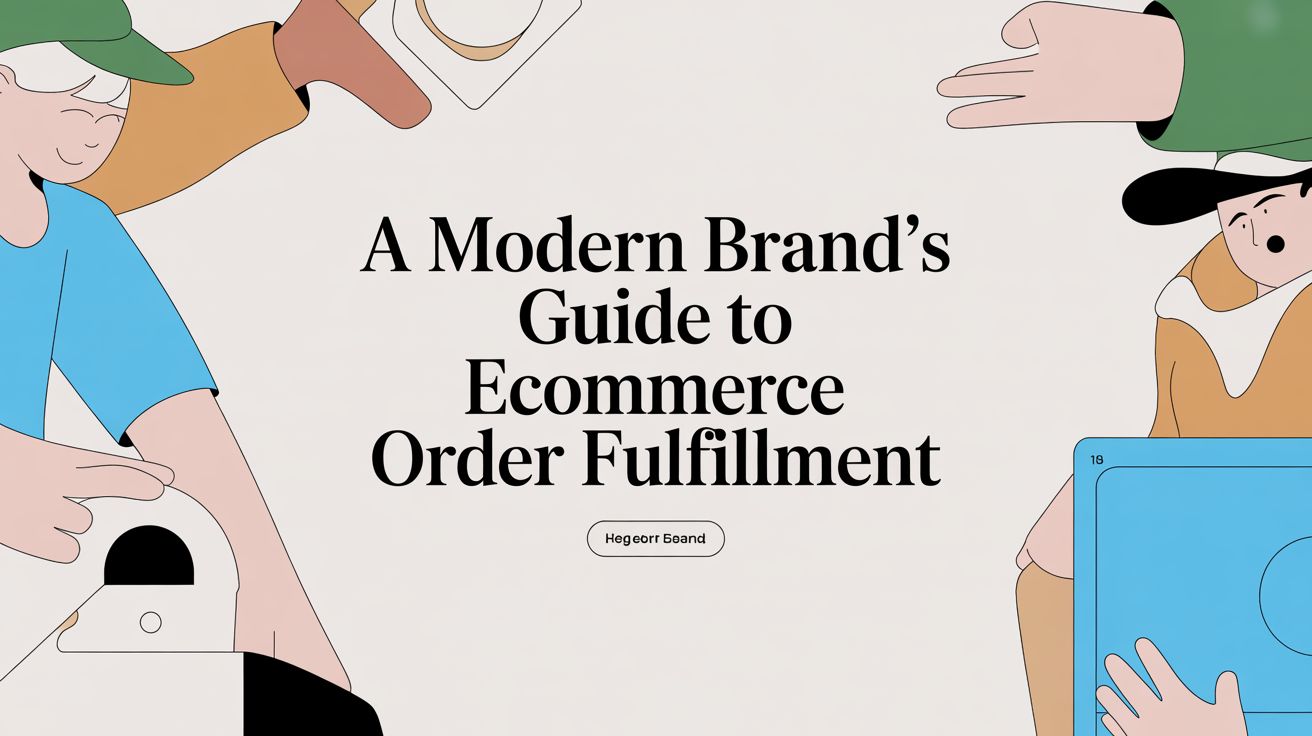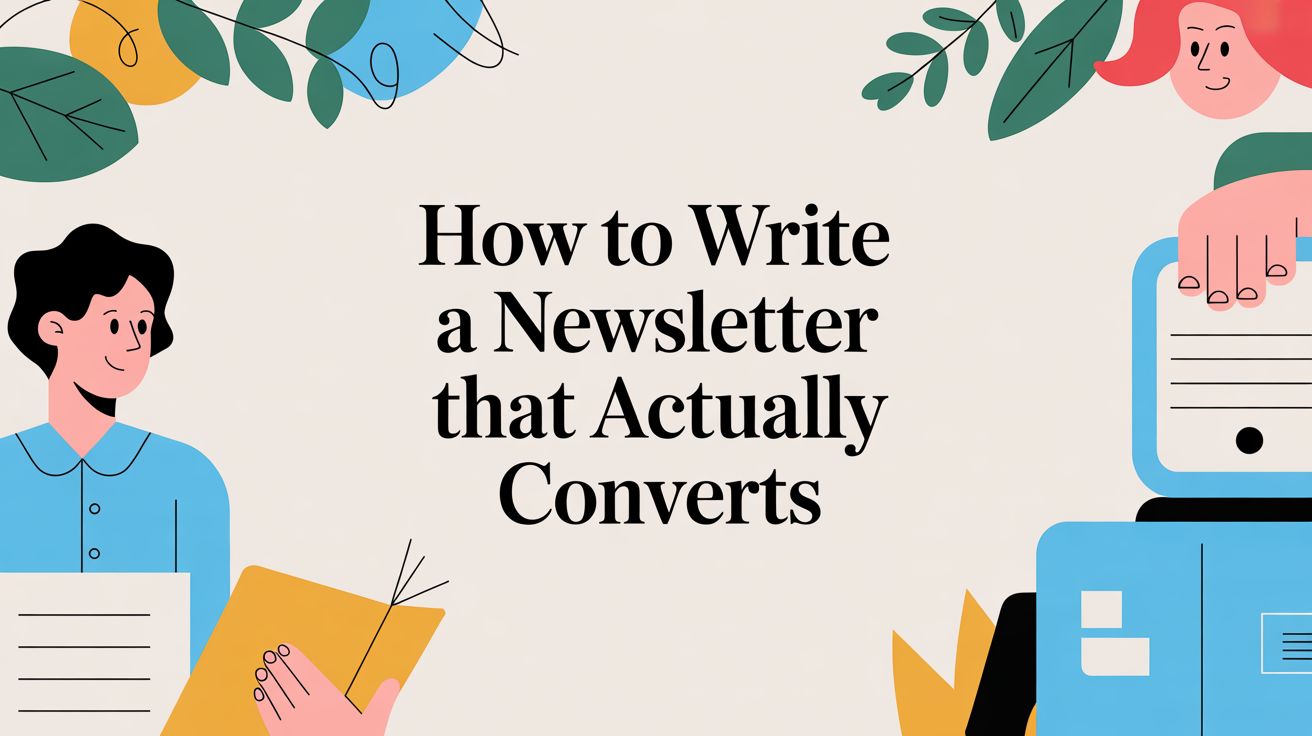
Shopify Popups: The Science of Driving Revenue & Conversions
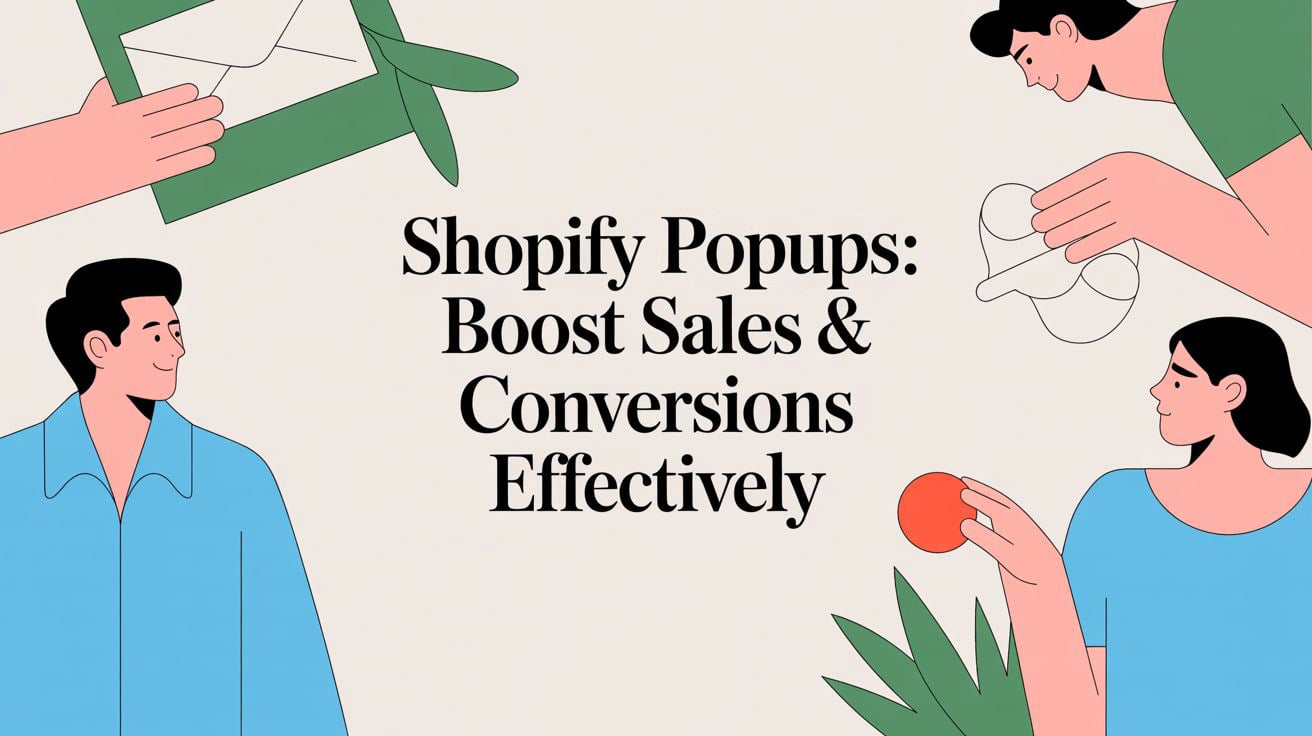
Shopify popups are more than just a tool to capture an email address. When grounded in consumer psychology, they become powerful, automated revenue drivers designed to influence buying decisions in the moment. By leveraging proven principles like urgency, scarcity, and loss aversion, a strategically-timed popup can measurably boost your average order value (AOV), reduce cart abandonment, and accelerate the entire path to purchase.
Moving Beyond Email Capture to Drive Immediate ROI
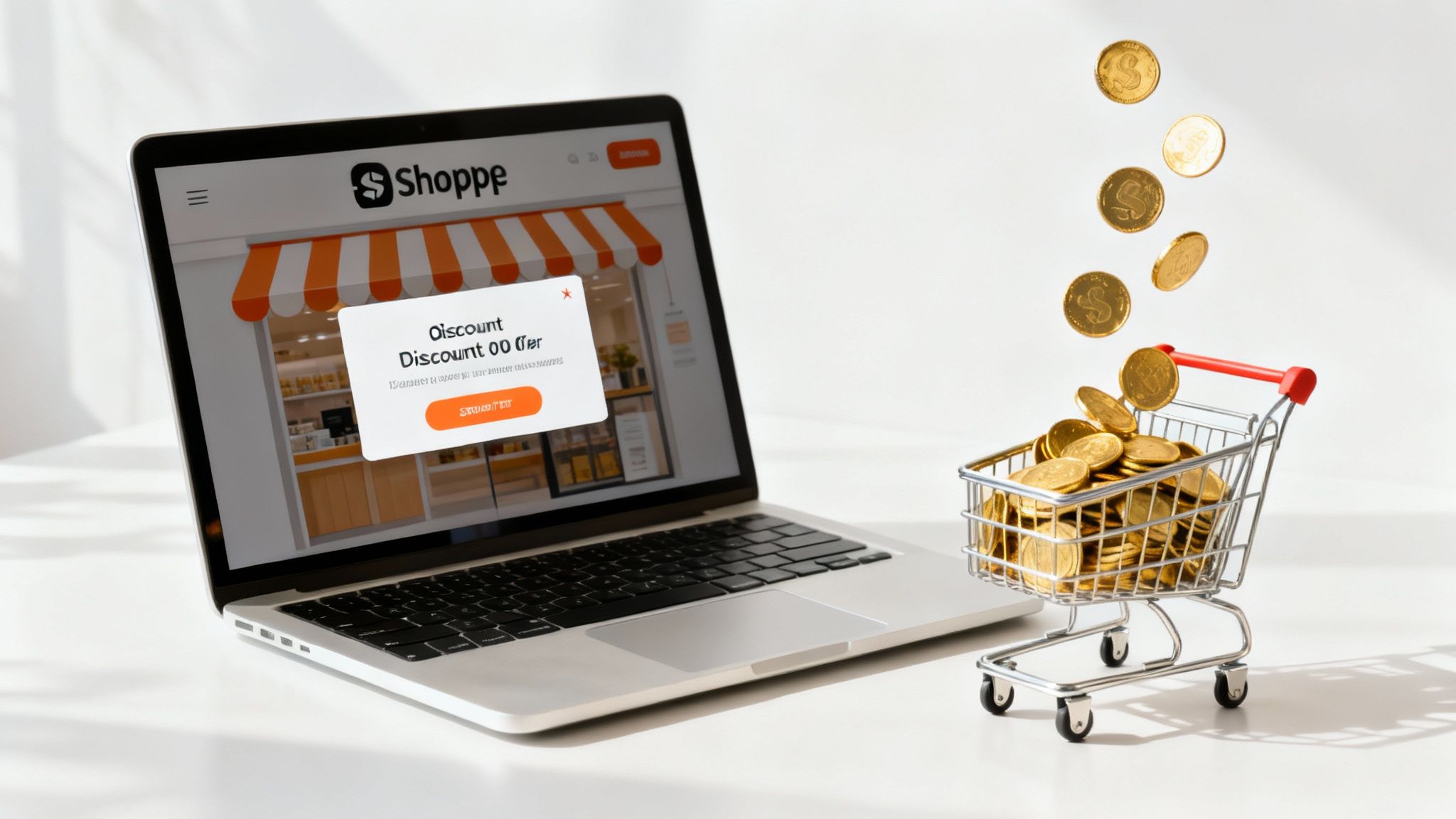
For years, the primary function of a popup was to build an email list. While valuable, this approach leaves significant potential revenue on the table by delaying the conversion.
Modern popups shopify strategies focus on immediate ROI, transforming these displays from passive lead magnets into active sales tools that protect profit margins and fuel growth. This represents a fundamental shift from a long-term goal (list building) to a critical, immediate one: completing a sale today. It’s a move away from generic "10% off for your email" offers to smart, behaviorally-triggered interactions that meet the shopper at a critical juncture. As a key component of effective Conversion Rate Optimization (CRO) strategies, these intelligent popups help nudge browsers into becoming buyers.
The True Business Impact of Smart Popups
When you implement a popup strategy grounded in behavioral science, you impact the business metrics that matter most, extending far beyond simple conversion rates. Brands that apply these principles see tangible financial results.
- Protecting Profit Margins: Instead of site-wide discounts that erode profits, intelligent popups can serve targeted offers only to shoppers exhibiting exit-intent, reserving discounts for sales that are genuinely at risk.
- Increasing Average Order Value (AOV): A popup triggered by cart value acts as a powerful nudge. A simple prompt like, "You're only $15 away from free shipping!" leverages the Goal-Gradient Effect, motivating shoppers to add one more item to reach a reward.
- Reducing Cart Abandonment: With industry cart abandonment rates hovering around a staggering 70%, an exit-intent popup offering a last-minute incentive is a critical defense for recovering what would otherwise be lost revenue.
- Improving Inventory Management: Need to move overstocked items? A flash sale popup for a specific product can clear warehouse space efficiently without resorting to a costly, site-wide clearance event.
By focusing on revenue generation over simple email capture, brands can reframe popups as a key component of their profitability strategy. The goal is to influence the immediate purchase decision, not just a future one.
This is the power of urgency marketing science. It's not about manipulative tactics; it's about understanding the behavioral economics that drive consumer decisions. At Quikly, we see this as the core of enhancing the entire shopper journey. It’s the evolution from basic countdown timers to sophisticated, automated revenue drivers that understand and react to human behavior.
The Psychology Behind High-Converting Popups
The best popups shopify stores use aren't just well-designed—they are engineered based on the science of decision-making. They move beyond a simple "10% Off" banner to tap into powerful behavioral triggers that compel shoppers to act. At Quikly, we approach urgency marketing as a science, leveraging these principles to create more effective customer experiences.
This strategy hinges on predictable patterns in human cognition. When a popup displays a ticking clock, it’s doing more than creating urgency; it's activating a well-documented human response to potential loss, known as loss aversion. By understanding these triggers, you can build a popup strategy that guides the shopper's journey and delivers a significant revenue boost.
Harnessing The Scarcity Principle
One of the most potent psychological tools in e-commerce is the Scarcity Principle. This foundational concept in behavioral economics, popularized by Dr. Robert Cialdini, states that humans place a higher value on items they perceive as being in short supply. When something is framed as rare, its desirability increases instantly.
A generic popup might just offer a discount, but a popup built on psychology signals scarcity.
- Low Inventory Alerts: A message like "Only 3 left in stock!" appearing when a customer views a product creates an immediate need to decide.
- Exclusive Access: Offering a "limited edition" product available only for a short time through the popup makes that item feel special and more coveted.
This is an effective way to accelerate the buying decision, shifting the customer's mindset from "I'll think about it" to "I need this now before it’s gone." The key is to strategically highlight real inventory constraints to spur action, which also helps with inventory management.
Activating Fear of Missing Out (FOMO)
Closely related to scarcity is the Fear of Missing Out (FOMO). This is the powerful anxiety that we might miss out on a rewarding experience that others are enjoying. For Shopify stores, FOMO is a key tool for converting hesitant shoppers, and popups are the ideal delivery mechanism.
A temporary popup with a definitive end date taps into a shopper’s fear of missing out. The limited-time nature creates a sense of urgency and exclusivity that drives people to shop now—or else risk missing out on a one-of-a-kind experience.
A flash sale popup with a prominent countdown timer doesn't just announce a sale; it makes the opportunity feel like it's slipping away. As explored in the marketing psychology behind scarcity and FOMO, these tactics reliably nudge consumers toward a purchase by transforming a simple discount into an exciting, can't-miss event.
Building Instant Trust with Social Proof
In an environment where shoppers are inherently skeptical, Social Proof is essential. This principle describes our natural tendency to look to the actions of others to determine the correct behavior in a given situation. When customers are uncertain, they seek cues from their peers.
A smart popup can display real-time activity, such as "27 people have bought this in the last hour!" This message accomplishes two critical things: it validates the product's popularity and creates a subtle sense of urgency. It communicates that others trust the brand and desire the item, lowering the perceived risk for a new shopper.
By integrating social proof directly into your popups shopify strategy, you build credibility at the precise moment of decision, dramatically increasing the likelihood of a conversion.
The Evolution From Simple Timers To Smart Triggers
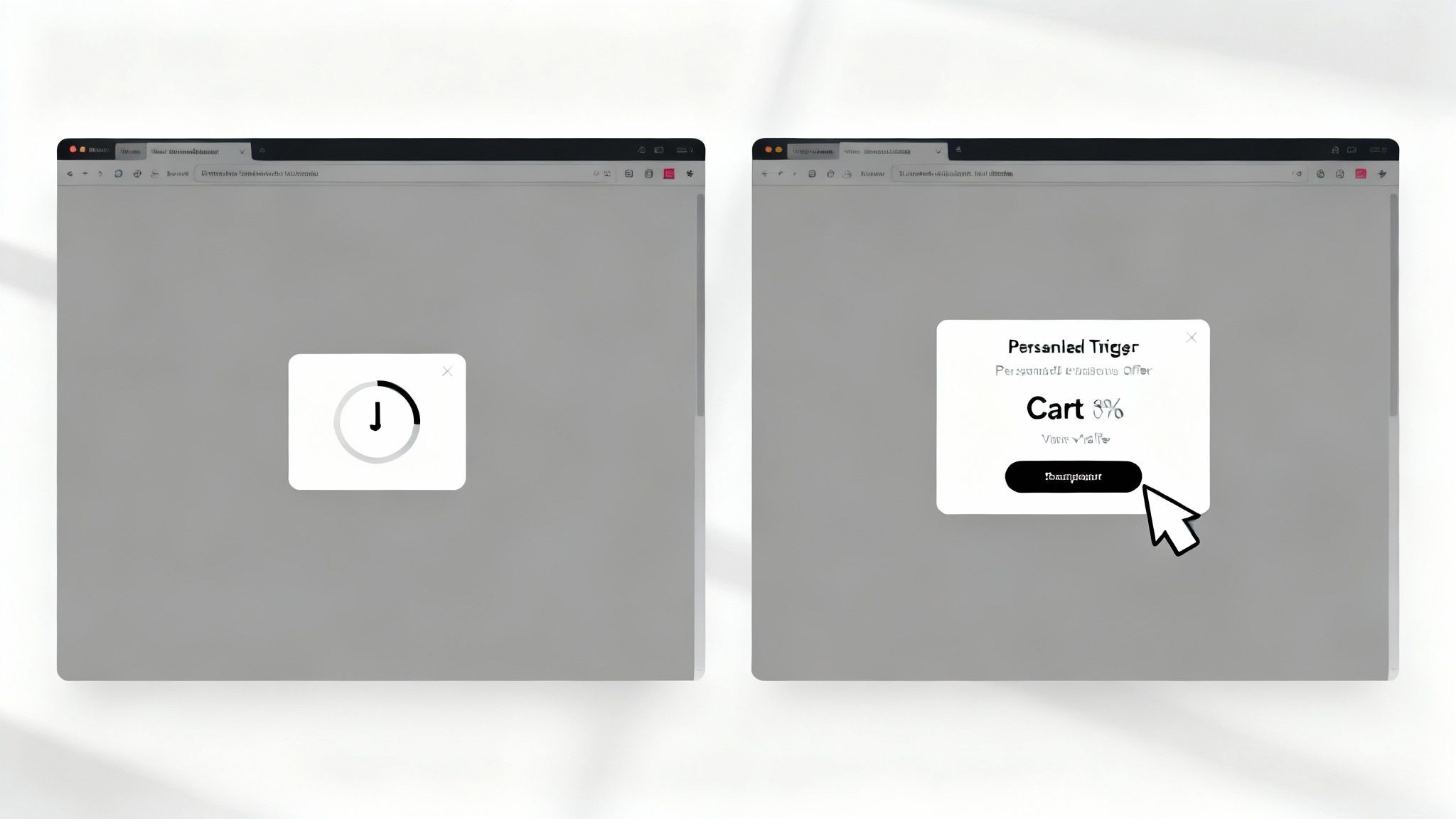
The landscape for popups Shopify merchants use has fundamentally changed. Previously, the primary goal was email capture. A generic popup with a simple countdown timer was displayed to every visitor, regardless of their behavior or intent.
This one-size-fits-all approach led to banner blindness, as shoppers became conditioned to ignore these intrusive offers. Legacy tactics focused on a single, long-term metric (list growth) while missing the immediate, high-impact goal of securing a sale now. The result was often a frustrated visitor and a lost revenue opportunity. Modern strategies have moved far beyond these basic timers, using smart automation to transform popups into reactive, intelligent sales tools.
The Rise Of Behavioral Triggers
The most significant advancement has been the shift to behavioral triggers. Instead of broadcasting the same message to everyone, smart popups react to a shopper's real-time actions on your site. This ensures the message is not only timely but also deeply relevant to the user's current mindset.
These triggers are rooted in consumer psychology, designed to provide the perfect nudge at the perfect moment.
- Exit-Intent Triggers: This is your last line of defense. The technology detects when a visitor is about to abandon their session, such as when their cursor moves toward the browser's back button. This is the prime moment to serve a compelling offer and rescue a sale that was seconds from being lost.
- Scroll-Depth Triggers: When someone scrolls deep into a product page, they are demonstrating clear interest. A popup can trigger at this point to offer a special bundle or highlight a key feature, providing the final push needed to add the item to their cart.
- Cart-Value Triggers: You can set a popup to appear when a shopper’s cart reaches a specific dollar amount. A message like, “You’re only $10 away from free shipping!” is a simple, direct way to increase your Average Order Value (AOV).
The move from generic timers to smart triggers is a fundamental shift from interruption to interaction. It's about adding value to the shopper's journey at critical decision points, not just asking for an email address upon arrival.
This strategic approach is far more effective at driving immediate revenue. You can get a deeper look into how to use these in our complete guide to exit-intent pop ups. This is what separates a basic popup app from a true urgency marketing platform like Quikly, where we build sophisticated, automated "Moments" that go beyond simple timers.
From Email Capture To Revenue Generation
This evolution has a direct, measurable impact on your bottom line. Smart, behavior-driven popups Shopify stores are putting to work have proven to be incredibly effective. The average popup conversion rate recently hit 4.65%, and Shopify stores in particular are seeing a click-through rate of 8.11%. This data makes it clear: when executed correctly, popups are a sales powerhouse.
The focus is no longer just on capturing an email for a future marketing sequence. The primary goal is to influence the current shopping session and drive a purchase today.
This could mean:
- Offering a shipping upgrade to a customer with a high-value cart, boosting their satisfaction and perceived value.
- Serving a small, targeted discount to a returning visitor who repeatedly views a specific product category.
- Using a social proof popup on a trending item, showing recent purchase activity to build trust and urgency.
For Shopify Plus merchants, these capabilities are even more crucial. They can use advanced triggers to segment high-volume traffic, delivering unique offers to different customer groups based on purchase history or location. This ensures every interaction is optimized for maximum ROI, protecting margins while driving real growth.
How To Launch Revenue-Driving Popup Campaigns
Moving from theory to tangible results is where business impact is made. Launching effective popups on your Shopify store isn’t about guesswork; it’s about deploying smart, psychologically-driven strategies that engage shoppers at precisely the right moments. Think of these not as ads, but as automated, revenue-driving conversations.
By focusing on specific shopper behaviors, you can create campaigns that feel less like interruptions and more like helpful nudges. Here is a blueprint for three high-impact popups Shopify campaigns you can implement immediately to drive sales and protect your bottom line.
The performance difference between a basic timer and a sophisticated, behavior-based trigger is significant.
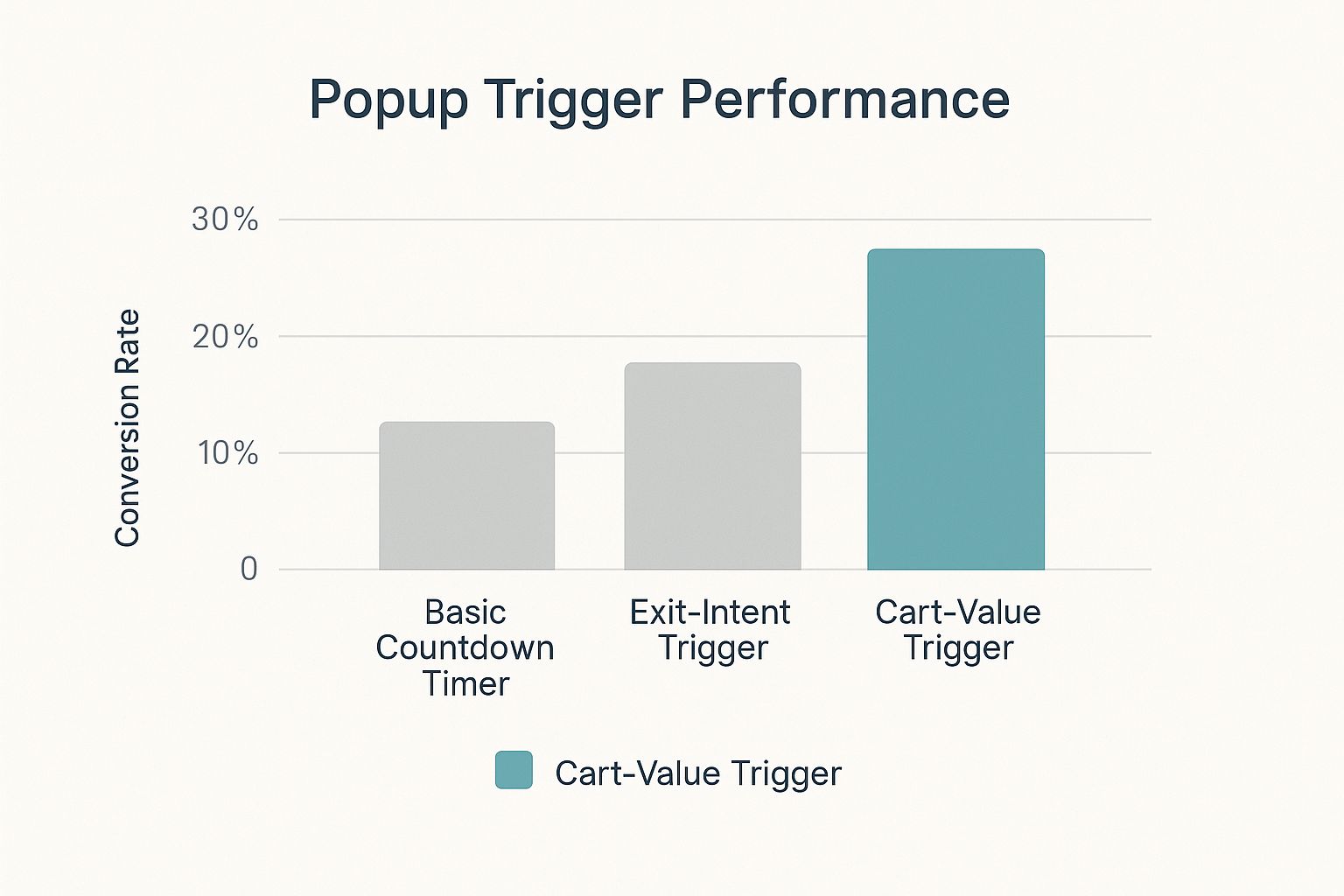
As this illustrates, campaigns triggered by a shopper's actual behavior—like reaching a certain cart value—convert at a much higher rate than a generic, one-size-fits-all timer.
Campaign 1: The Cart Abandonment Savior
With the industry average cart abandonment rate at a staggering 70%, this campaign is your single most important defense against lost revenue. The mission is to re-engage a shopper exhibiting exit-intent—a clear sign they're about to leave.
Here, behavioral economics is your superpower. By presenting a compelling offer at this exact moment, you trigger loss aversion, making the shopper reconsider abandoning their items.
Actionable Takeaway:
- Set the Trigger: Configure your popup to fire only when a user’s cursor moves toward the browser's exit or back button, specifically on the cart or checkout pages.
- Craft the Offer: The offer must be valuable but also margin-aware. Instead of a blanket discount, try a tiered offer like, "Complete your order in the next 10 minutes and get 15% off." This introduces urgency.
- Shopify Targeting: Target this popup to appear only for carts containing items from your best-seller collection or for first-time visitors who have added at least one item to their cart.
- Klaviyo Integration: If a user closes the popup, the opportunity isn't lost. Sync their data with Klaviyo or your SMS platform to trigger a follow-up abandoned cart message that references the same limited-time deal. This creates a cohesive, multi-channel safety net.
Campaign 2: The AOV Booster
Increasing revenue doesn't always require more traffic. A quick path to growth is increasing your Average Order Value (AOV). This campaign uses a cart-value trigger to encourage shoppers to add just one more item.
The psychological hook is gamification and the Goal-Gradient Effect. Shoppers see a clear goal (like free shipping) and a direct path to achieving it. Adding more to their cart feels like a small, satisfying win.
Actionable Takeaway:
- Find Your Threshold: Analyze your Shopify data to determine your current AOV. Set your popup trigger to appear when a shopper’s cart is about 15-20% below your free shipping threshold.
- Create a Tiered Offer: The copy should be direct and helpful: "You're only $15 away from FREE shipping!" This brilliantly reframes the action from spending more to saving money on shipping.
- Smart Product Recommendations: For Shopify Plus merchants, use advanced rules to recommend specific, low-cost "cart-filler" products within the popup, making it nearly effortless for the shopper to reach the goal.
This strategy is far superior for your profit margins than offering site-wide free shipping. You’re rewarding customers who are already spending more, directly incentivizing the exact behavior you want to cultivate.
Campaign 3: The New Product Launch Driver
Anticipation is a powerful marketing tool. For a new product launch, a strategically timed series of popups Shopify can build excitement and secure early sales from your most enthusiastic customers.
This campaign leverages the principles of exclusivity and anticipation. By giving a select group early access or a special launch-day offer, you make them feel like insiders, strengthening loyalty and guaranteeing crucial initial sales velocity.
Actionable Takeaway:
- Pre-Launch Teaser: A week before launch, deploy a simple email capture popup on your homepage: "Our new collection drops next week. Sign up for exclusive early access."
- Segment Your Audience: On launch day, ensure your special popup is shown only to the intended audience. Target visitors who are on the "early access" email list (using URL parameters from your Klaviyo or SMS launch message) or returning VIP customers.
- Launch Day Urgency: The popup should feel like an event. Use a message that creates a sense of occasion: "Welcome back! As promised, here's your exclusive 24-hour launch discount. Shop the new collection now!"
- Multi-Channel Reinforcement: Coordinate the popup with SMS and email announcements to the same segmented audience. This ensures your most loyal fans see the message and act fast, providing vital social proof from day one.
Urgency Popup Campaign Blueprint for Shopify
| Campaign Goal | Psychological Principle | Shopify Trigger | Popup Offer Example | Primary ROI Metric |
|---|---|---|---|---|
| Reduce Cart Abandonment | Loss Aversion & Urgency | Exit-Intent on Cart Page | "15% off if you order in 10 minutes!" | Recovered Revenue |
| Increase Average Order Value | Gamification & Goal Proximity | Cart Value Threshold | "You're $15 away from free shipping!" | AOV Increase |
| Drive Launch Day Sales | Exclusivity & Anticipation | Returning Customer / URL Param | "Exclusive 24-hour launch day discount!" | Sales Velocity |
By grounding your popup strategy in proven psychological principles and tying it to specific business goals, you transform these tools from simple annoyances into powerful engines for growth.
Measuring The Metrics That Actually Matter
Executing a well-designed popup campaign is only half the equation. To understand its true effectiveness, you must look beyond surface-level numbers like email captures and focus on the KPIs that directly impact your revenue. A large email list is an asset, but a measurable lift in your average order value (AOV) is what truly moves the needle.
This is where a true urgency marketing platform distinguishes itself from basic popup apps. The goal isn’t just to see how many people saw an offer; it’s to draw a direct line from a specific popup interaction to a completed sale. This attribution allows you to prove ROI and make decisions based on data, not assumptions.
Moving From Vanity Metrics To Revenue Impact
A common mistake Shopify merchants make is tracking the wrong metrics. An email signup feels like a victory, but it's the beginning of a process, not the final outcome. True success is measured in dollars.
It’s time to shift your focus to metrics that tell a story about your financial health.
- Popup-Influenced Revenue: This is your north star metric. It represents the total revenue generated from shoppers who engaged with a popup before checking out. This is direct attribution that proves your campaign is profitable.
- Average Order Value (AOV) Lift: Are those "Spend $10 more for free shipping" popups effective? Track the AOV of customers who interacted with an AOV-booster popup versus those who didn't. A positive lift is a clear sign you’re successfully encouraging larger purchases.
- Cart Abandonment Rate Reduction: The industry benchmark for cart abandonment is a painful 70%. By launching an exit-intent popup, you can measure the direct drop in that rate and calculate exactly how much revenue your campaign is recovering.
When you switch your focus to revenue, the entire conversation changes. It shifts from "How many emails did we get?" to "How much profit did this campaign generate?" That's how you justify marketing spend and optimize for genuine growth.
Setting The Right Benchmarks
Performance requires context. The average conversion rate for a Shopify store typically falls between 1.4% and 1.8%. The top 10% of merchants are converting above 4.7%. These figures, especially when broken down by mobile (1.2%) and desktop (1.9%), highlight the significant room for improvement. You can dive deeper into these e-commerce conversion benchmarks to see how you stack up.
With these industry benchmarks as your baseline, you can set realistic goals. If your store converts at 1.5%, and a new popup campaign lifts that to 2% for users who engage with it, that is a substantial win.
Taking Your Strategy to the Next Level with Advanced Urgency
The era of the generic, one-size-fits-all popups Shopify stores use is over. To cut through the noise in today's market, you must move beyond basic email capture toward a more sophisticated strategy rooted in the science of consumer behavior. This isn't about manipulation; it's about making the shopping experience genuinely exciting and providing clarity at critical moments of decision.
The real shift is from passively collecting leads to actively generating revenue. Instead of just adding a name to an email list for later, advanced urgency marketing influences the purchase happening right now, boosting order values and protecting profit margins in real-time.
From Simple Timers to Smart Behavioral Automation
Many brands still use simple countdown timers, but shoppers have become desensitized to them, leading to banner blindness and diminishing strategic value. The future lies in automated campaigns triggered by actual shopper behavior. Think of it as a personalized conversation with each visitor. You can explore the differences in our guide on what countdown timer Shopify free apps offer versus more advanced tools.
This smarter, automated approach allows you to:
- Protect Your Margins: Instead of site-wide price cuts, present targeted offers only to shoppers who are about to abandon their cart.
- Manage Inventory: If you have overstock, run a surgical flash sale for that specific product without devaluing your entire brand.
- Drive Real Growth: Use real-time data to personalize offers, converting casual browsers into loyal, repeat customers.
The opportunity is massive. With Shopify merchants generating billions in sales, optimizing every interaction is how you secure your market share. During Black Friday Cyber Monday, Shopify merchants hit $9.3 billion in sales—a 19% increase in just two years. That staggering transaction volume highlights how much revenue is at stake. You can learn more about Shopify's impressive growth and conversion stats here.
By embracing a smarter, psychology-backed approach to urgency, you can move beyond simple popups and build an automated system that not only captures attention but drives tangible, sustainable revenue growth for your Shopify store.
Your Top Shopify Popup Questions, Answered
When you hear the word "popup," you might picture annoying, screen-blocking ads. Many store owners worry they’ll disrupt the shopping experience or frustrate their customers.
But modern popups are different. When your strategy is grounded in real consumer psychology and focused on adding value, popups become a helpful part of the shopping journey, not a detour. Let's address the biggest questions.
Will Popups Wreck My Site's SEO or User Experience?
This is a primary concern, and it's valid—bad popups are bad for business. Intrusive, hard-to-close popups frustrate users. In fact, Google penalizes sites that use intrusive interstitials on mobile devices.
However, a smart, behavior-based popup is a completely different tool. An exit-intent offer that saves a sale or a helpful free shipping reminder enhances the experience. When a popup provides genuine value, like a relevant discount or useful information, it feels less like an ad and more like a helpful service.
The key is timing and relevance. A strategically-triggered popup that respects the customer's journey has no negative SEO impact and can significantly improve engagement and conversion rates.
What’s the Real Difference Between an Email Popup and a Revenue Popup?
This is a crucial distinction between playing the long game and winning the sale now. While they may look similar, their objectives are fundamentally different.
- Email Popups focus on lead capture. The goal is to acquire an email address with the hope of converting that person later through a nurture sequence. The immediate return on the interaction is zero.
- Revenue Popups are designed for an immediate financial outcome. They leverage psychological triggers like scarcity or limited-time offers to influence the purchase decision happening in that moment. The goal is to directly boost conversion rates and Average Order Value (AOV) before the visitor leaves.
Essentially, an email popup asks for a future conversation. A revenue popup drives an immediate transaction. It is a direct lever you can pull to increase profitability today.
How Can I Actually Use Popups Without Annoying People?
This is the central question. The answer lies in abandoning "one-size-fits-all" campaigns and adopting a psychological approach. To use popups that help rather than hinder, focus on these four elements:
- Get Smart with Behavioral Targeting: Don't show a popup simply because someone landed on your site. Trigger it based on their actions. Are they about to leave (exit-intent)? Have they viewed multiple products in a category? Did their cart just cross a key threshold? Match the message to the moment.
- Don't Be Clingy: Bombarding a visitor with the same offer repeatedly is ineffective. Limit how often a user sees a popup—perhaps once per session or once every few days. Respect their experience.
- Offer Something Genuinely Valuable: A popup is an interruption, so make it worthwhile. A meaningful discount, a free shipping upgrade, or exclusive access to a new product feels like a fair exchange for their attention. A weak offer is simply intrusive.
- Always Provide an Easy Out: The close button ("X") should be obvious and easy to click. Trapping a user on your site is the fastest way to ensure they never return.
When you adhere to these rules, popups cease to be a nuisance and become a welcome and effective part of the e-commerce experience.
Ready to transform your Shopify popups from simple lead forms into powerful revenue engines? Quikly provides the advanced, psychology-driven tools you need to create urgency, increase AOV, and drive immediate sales. See how Quikly can elevate your strategy.

The Quikly Content Team brings together urgency marketing experts, consumer psychologists, and data analysts who've helped power promotional campaigns since 2012. Drawing from our platform's 70M+ consumer interactions and thousands of successful campaigns, we share evidence-based insights that help brands create promotions that convert.
